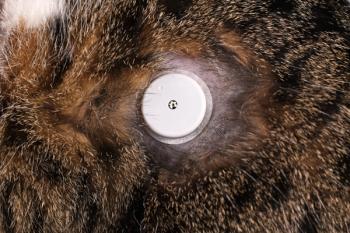
Torsemide for canine CHF: Emerging evidence and clinical benefits

William Rausch, DVM, DACVIM (Cardiology), explains that torsemide offers at least equivalent efficacy to furosemide in canine CHF while significantly reducing short-term mortality/worsening events by approximately 50%.
At the 2025 Fetch dvm360 Conference in Nashville, Tennessee, on May 31, 2025, William Rausch, DVM, DACVIM (Cardiology), presented “Torsemide: When, How and Why I Use It in Canine Heart Failure.” Rausch highlighted that loop diuretics remain the cornerstone of congestive heart failure (CHF) therapy but noted evolving evidence suggesting torsemide may outperform the long-standing “workhorse” furosemide in certain clinical scenarios.1
Pharmacokinetic advantages of torsemide
Rausch explained that torsemide’s pharmacokinetic profile may offer advantages over furosemide. In dogs, torsemide has a half-life of approximately 12 hours compared with 5 to 6 hours for furosemide, allowing for sustained diuresis with fewer daily doses. He stated, “Torsemide just might be that next step, which is...a super exciting thing…. Lasix has always been such an assumption, and it’s been a workhorse, and it’s been wonderful. But I think there may be more benefit to be had with torsemide.” He further emphasized that torsemide is “about 10 to 20 times as powerful” on a milligram-to-milligram basis and noted, “I’ve never treated a dog with more than twice-a-day torsemide, ever. And many of my patients are on [once-daily].”¹
Clinical trial evidence
To substantiate these claims, Rausch reviewed the TEST study, a prospective, randomized, blinded, positive-control clinical trial conducted in Europe. Enrolling 366 dogs with stable CHF secondary to degenerative mitral valve disease, the trial compared twice-daily furosemide to once-daily torsemide while maintaining all other cardiac medications (eg, ACE inhibitors, pimobendan, spironolactone) unchanged. Investigators defined clinical success using a composite scoring system that included thoracic radiographs, physical examination findings, and owner-reported signs (cough, appetite, activity). A second end point was the risk of death, euthanasia due to CHF progression, or the need to escalate diuretic dosing. At 3 months, 60% of torsemide-treated dogs vs 55% of furosemide-treated dogs “remained stable,” demonstrating noninferiority of torsemide.1,2
More strikingly, Rausch highlighted, “over the course of those 3 months, about 22% [of dogs on furosemide] died or had severe worsening heart failure. In the torsemide group, 11%. So, a 50% reduction in your risk of dying or having worsening heart failure.” Despite torsemide’s greater potency, mortality due to renal failure was similar between groups (2% furosemide vs 4% torsemide; not statistically significant).1,2 He said that higher rates of polyuria/polydipsia and mild, nonserious increases in blood urea nitrogen or creatinine were seen with torsemide, but that in over 90% of cases, no dose adjustment was required.
Rausch then summarized a US-based, noninferiority trial beginning at first CHF diagnosis rather than stable disease. Dogs presenting in CHF were randomized to receive either once-daily torsemide or twice-daily furosemide, along with other indicated cardiac therapies. At 3 months, torsemide again demonstrated noninferiority in maintaining clinical stability; 23% of furosemide-treated dogs experienced death or CHF-related decompensation vs 13.7% of torsemide-treated dogs, replicating the approximately 50% risk reduction observed in TEST. Both trials reported higher rates of polyuria/polydipsia and transient, nonserious renal parameter elevations with torsemide.1,3
Dosing and monitoring considerations
From a clinical standpoint, Rausch advocated converting furosemide to torsemide using a sliding-scale potency ratio, approximately 1:10 at lower furosemide doses and up to 1:15 to 1:20 at higher doses. He recommended obtaining baseline renal panels, rechecking bloodwork at 48 to 72 hours, and scheduling follow-up exams and labs at 1 month, mirroring trial surveillance frequency.
Owner compliance and practical considerations
On owner compliance, Rausch stated, “There was better compliance in the torsemide group than the furosemide group. And these are people in a clinical trial…you’d think they’d be 100% compliant, right? It’s just like real life.”1 He also stressed selecting clients who would reliably return for monitoring: “I choose my clients pretty carefully who I’m doing this on. I wouldn’t just do this for any client…I want you to come back in a week for blood work with our technicians—they’re going to do that.”1
Takeaway
Rausch communicated to the attendees that torsemide offers at least equivalent efficacy to furosemide in canine CHF, with the added benefits of halved morbidity and mortality over 3 months and improved owner compliance due to once-daily dosing. Rausch suggested that these findings support earlier adoption of torsemide, particularly for patients struggling with high-frequency dosing or recurrent decompensations. Further long-term studies may clarify whether torsemide’s short-term advantages translate into prolonged survival and enhanced quality of life.
References
- Rausch W. Torsemide – when, how and why I use it in canine CHF. Presented at: Fetch Nashville. May 31, 2025. Nashville, Tennessee.
- Chetboul V, Pouchelon JL, Menard J, et al. Short-term efficacy and safety of torasemide and furosemide in 366 dogs with degenerative mitral valve disease: the TEST study. J Vet Intern Med. 2017;31(6):1629-1642. doi:10.1111/jvim.14841
- Besche B, Blondel T, Guillot E, Garelli-Paar C, Oyama MA. Efficacy of oral torasemide in dogs with degenerative mitral valve disease and new onset congestive heart failure: the CARPODIEM study. J Vet Intern Med. 2020;34(5):1746-1758. doi:10.1111/jvim.15864
Newsletter
From exam room tips to practice management insights, get trusted veterinary news delivered straight to your inbox—subscribe to dvm360.






